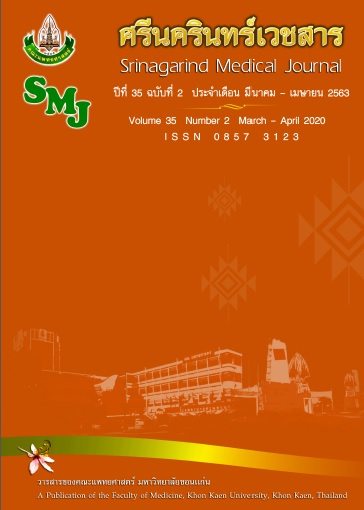Proportion of the Medical School Personnel Who Completely Resumed to Their Original Work after Sickness Absence
Keywords:
Return to work assessment; healthcare personnel; resumed to original work; Occupational healthAbstract
Background and Objectives: On occupational health service issues when personnel is injured or sick, fitness for work evaluation is necessary to assess the ability to return to work without risk to him/herself, others and the public. This study aimed to 1) study the proportion of personnels who completely resumed to their original work in the optimal time after sickness absence 2) study factors related to return to original work in the optimal time
Materials and Methods: A descriptive study was conducted in 104 personnels who were assessed for a returning to work from 1 October 2016 - 31 May 2018. Personal health and job informations were obtained together with the result of return to work assessment. Descriptive statistics and Inferential statistics were applied. Results: Personnel injured or sick could resume to original work in the optimal time at 79.8 percent (83/104). The most diseases which were assessed for returning to work were infectious diseases 45.2%, followed by musculoskeletal disease 25% and skin disease 8.7%. Factors related to resume to original work were female (OR 4.9, 95%CI: 1.7, 13.9, p<0.01) and direct contact to patient (OR 3.8, 95%CI: 1.1,12.4, p-value=0.03).
Conclusion: The proportion of personnel who completely resumed to their original work was lower than previous studies. Female and direct contact with the patient were a possibility of resumed to original work. This might be caused by only statistical relationships because most personnels were female. The analytical design should be continued
References
2. Costa G. Shift work and health: current problems and preventive actions. Saf Health Work 2010; 1: 112–23.
3. Tipayamongkholgul M, Luksamijarulkul P, Mawn B, Kongtip P, Woskie S. Occupational hazards in the Thai healthcare sector. New Solut 2016; 26: 83–102.
4. Chang SS, Gunnell D, Sterne JA, Lu TH, Cheng AT. Was the economic crisis 1997-1998 responsible for rising suicide rates in East/Southeast Asia? A time-trend analysis for Japan, Hong Kong, South Korea, Taiwan, Singapore and Thailand. Soc Sci Med 2009; 68: 1322-31.
5. Jin RL, Shah CP, Svoboda TJ. The impact of unemployment on health: a review of the evidence. CMAJ 1995; 153: 529-40.
6. Ashley J, Cashdollar W, Etcheverry R, Magill K. Transition back to work: policies to support return to work after illness or injury. Washington (DC): Office of Disability Employment Policy, U.S. Department of Labor, 2017.
7. Health and Safety Executive. Managing sickness absence and return to work [online]. n.d. [cited 2019 Jun 29]. Available from: https://bit.ly/1B14dWh
8. Office of Parliamentary Counsel. Return to work regulations 2015 [online]. 2015 [cited Jun 29, 2019]. Available from: https://bit.ly/2nqsgl5
9. กฎกระทรวงกำหนดหลักเกณฑ์และวิธีการตรวจสุขภาพของลูกจ้าง และส่งผลการตรวจแก่พนักงานตรวจแรงงาน พ.ศ. 2547. ราชกิจจานุเบกษา เล่มที่ 122, ตอนที่ 4 ก. (13 มกราคม 2548): 19-22.
10. พระราชบัญญัติความปลอดภัย อาชีวอนามัย และสภาพแวดล้อมในการทำงาน พ.ศ. 2554. ราชกิจจานุเบกษา เล่มที่ 128, ตอนที่ 4 ก. (17 มกราคม 2554): 5-25.
11. สถาบันรับรองคุณภาพสถานพยาบาล (องค์การมหาชน). ภาพรวมของการบริหารองค์กร. ใน: มาตรฐานโรงพยาบาลและบริการสุขภาพ ฉบับที่ 4. นนทบุรี: สถาบัน, 2561: 9–50.
12. 12. Untimanon O, Promrat A, Bomephong K, Laplue A, Siriruttanapruk S. Twelve years of occupational health services for health workers: accreditation system implemented in the hospitals across Thailand. J Med Assoc Thai 2019; 102 (Suppl 1): S1-5.
13. กฎกระทรวงกำหนดมาตรฐานในการบริหารและการจัดการด้านความปลอดภัย อาชีวอนามัย และสภาพแวดล้อมในการทำงาน พ.ศ. 2549 ราชกิจจานุเบกษา เล่มที่ 123, ตอนที่ 65 ก. (21 มิถุนายน 2549): 4-20.
14. European Commission. Occupational health and safety risks in the healthcare sector: guide to prevention and good practice. Luxembourg: European Commission, 2011.
15. Chaiear N, Seehamoke C, Krisorn P, Soonthornvinit W, Janpho P, Lertruampattana S, et al. Occupational Health and Safety Management System: Implementation at the Faculty of Medicine, Khon Kaen University, Khon Kaen, Thailand. J Med Assoc Thai 2019; 102 (Suppl 1): 65–8.
16. ธนิยะ วงศ์วาร, วิวัฒน์ เอกบูรณะวัฒน์. อัตราการกลับเข้าทำงานของผู้ประสบอันตรายหรือเจ็บป่วยเนื่องจากการทำงานในปี พ.ศ. 2556 และปัจจัยที่มีความสัมพันธ์. วารสารสาธารณสุข มหาวิทยาลัยบูรพา 2558; 10: 97–108.
17. สำนักงานสถิติแห่งชาติ. โครงสร้างของการจัดประเภทอาชีพตามมาตรฐานสากล (ISCO - 08 (ฉบับแปลภาษาไทย)) [ออนไลน์]. 2555 [อ้างเมื่อ 10 กันยายน 2562]. จาก https://bit.ly/3374E4m
18. Talmage JB, Melhorn JM, Hyman MH, American Medical Association, editors. AMA guides to the evaluation of work ability and return to work. 2nd ed. Chicago (IL): American Medical Association, 2011.
19. Williams T. Fitness for work after surgery [online]. 2015 [cited Jun 29, 2019]. Available from: https://bit.ly/33aSHuh
20. Majeed AW, Brown S, Williams N, Hannay DR, Johnson AG. Variations in medical attitudes to postoperative recovery period. BMJ 1995; 311: 296.
21. Ratzon N, Schejter-Margalit T, Froom P. Time to return to work and surgeons’ recommendations after carpal tunnel release. Occup Med (Lond) 2006; 56: 46–50.
22. Joosen M, Arends I, Lugtenberg M, van Gestel H, Schaapveld B, van der Klink J, et al. Barriers to and facilitators of return to work after sick leave in workers with common mental disorders: Perspectives of workers, mental health professionals, occupational health professionals, general physicians and managers. Wigston: Institution of Occupational Safety and Health, 2017.
23. วัลย์ลดา เลาหกุล, “ผลลัพธ์การประเมินกลับเข้าทำงาน โรงพยาบาลสมุทรสาคร หลังการได้รับการประเมินก่อนกลับเข้าไปทำงาน,” ในการประชุมวิชาการด้านโรคจากการประกอบอาชีพและสิ่งแวดล้อมแห่งชาติครั้งที่ 8, วันที่ 1-3 มีนาคม 2560 ณ โรงแรมมิราเคิลแกรนด์ คอนเวนชั่น จังหวัดกรุงเทพมหานคร.
24. Nanda P. Female health workers -- responsibilities and constraints. Health Millions 1993; 1: 25–6.
25. Kucera KL, Roos KG, Hootman JM, Lipscomb HJ, Dement JM, Silverstein BA. Work-related illness and injury claims among nationally certified athletic trainers reported to Washington and California from 2001 to 2011. Am J Ind Med 2016; 59: 1156–68.
26. Ribeiro RP, Martins JT, Marziale MHP, Robazzi ML do CC. [Work-related illness in nursing: an integrative review]. Rev Esc Enferm USP 2012; 46: 495–504.
27. นิภาพรรณ สฤษดิ์อภิรักษ์, วันชัย อาจเขียน, วราลักษณ์ ตังคณะกุล, อำนวย ทิพศรีราช, สุภาวิณี แสงเรือน, บรรณาธิการ. มาตรฐานและแนวทางปฏิบัติงานทีมเฝ้าระวังสอบสวนเคลื่อนที่เร็ว (SRRT). ฉบับปรับปรุงใหม่. นนทบุรี: สำนักระบาดวิทยา, 2555.
28. พระราชบัญญัติหลักประกันสุขภาพแห่งชาติพ.ศ. 2545. ราชกิจจานุเบกษา เล่มที่ 119, ตอนที่ 116 ก. (11 พฤศจิกายน 2545): 1-28.



